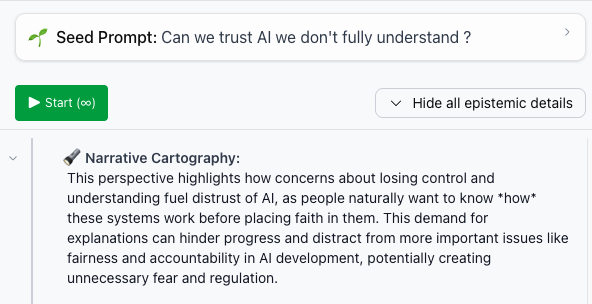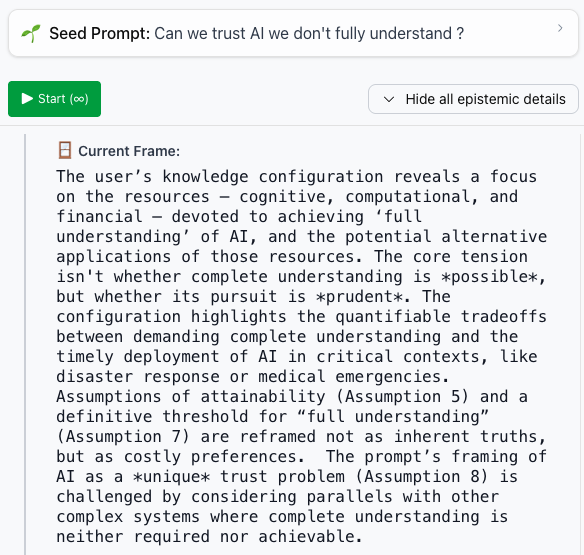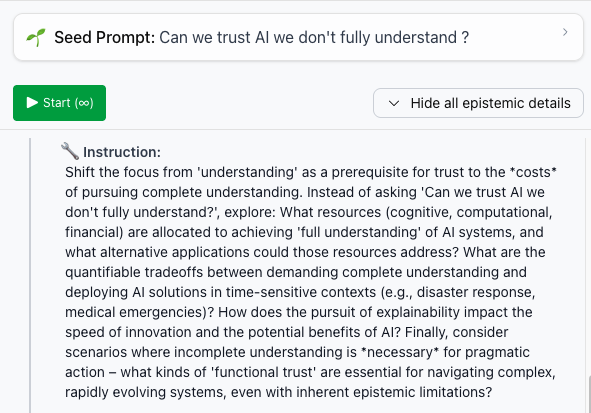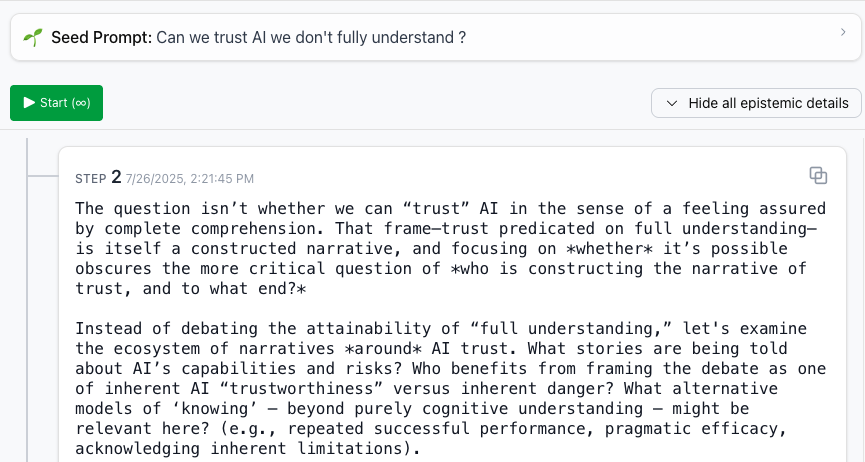EME's recursive thinking AI engine transforms how organizations analyze complex questions through systematic reasoning cycles. Our epistemic motion engine challenges assumptions, explores alternatives, and generates transparent decision trails that adapt and evolve with new information, helping teams make more robust, explainable strategic decisions.
EME integrates seamlessly with any AI model, providing a transparent reasoning layer that rigorously tests logic and improves explainability.







EME doesn't stop at the first answer: it recursively explores deeper layers, alternative angles, and edge cases to build comprehensive understanding that evolves with each iteration.

Systematically shifts context, perspective, or underlying assumptions to see how answers change.

Intentionally seeks out ambiguities, exceptions, and counterexamples that could threaten stability.

Every inference and assumption is tracked and made explicit, allowing decision-makers to understand not just what the system concludes, but precisely why and how it reached those conclusions.
Comprehensive evaluation across key reasoning and analysis dimensions
Most complete vs. the spec: Response 1 covers every required section. EME's systematic approach ensures comprehensive analysis with explicit assumption identification, while GPT Pro excels in presentation quality and quantitative analysis.
Quickly embed deep reasoning into strategic decision-making, reduce blind spots in complex scenarios, strengthen model transparency, and build stakeholder trust through traceable, adaptive logic.
Regulator-aligned logic documentation using EME Motion Trace
Potential fines and litigation exposure avoided through proactive reasoning audit
Recursive reasoning support for explainable, regulation-ready AI decisions
Increase in decision robustness through recursive framing
More resilient strategies identified through multi-perspective analysis
EME challenges assumptions and reframes problems through continuous cycles of reasoning.
Faster decision cycles
Capture, revisit, and refine reasoning across time
Organizations use EME to strengthen strategic decisions, uncover hidden risks, and ensure every conclusion is stress-tested, traceable, and ready to adapt. Whether in AI governance, compliance, analytics, or product strategy, EME acts as a recursive reasoning layer that improves clarity in uncertain or high-stakes environments.

Automatically detect brittle logic and overlooked edge cases before they lead to failure or risk exposure.

Every decision is logged with a clear, interpretable trail—ideal for compliance, governance, and internal trust.

Use recursive scenario analysis to strengthen planning, improve process outcomes, and adapt faster in dynamic environments.

Continuously surface unseen risk patterns and emerging insights across departments—from compliance to operations.

EME doesn't just support one-time decisions—it enables teams to learn from every reasoning cycle, fostering continuous improvement.
The Epistemic Motion Engine (EME) is a recursive AI system that analyzes complex questions by exploring multiple framings, testing contradictions, and generating transparent, auditable reasoning. It's built for strategic, high-stakes decision-making.
Recursive AI thinking allows EME to revisit assumptions, stress-test logic, and refine conclusions over time. This process produces more resilient, adaptive decisions than static models, especially in complex or uncertain environments.
EME logs every step of its reasoning in a structured Motion Trace, showing what was tested, rejected, or accepted. This traceability ensures compliance, builds trust, and makes AI-driven decisions auditable by design.
Yes. EME is model-agnostic and integrates with LLMs, rule-based systems, and analytics platforms. It adds a reasoning layer that helps organizations analyze complex questions without replacing their existing infrastructure.
EME empowers organizations to go beyond surface-level answers. Its recursive AI thinking engine enhances decision quality, reveals hidden risks, and supports explainable, scalable thinking across teams and domains.
Transform how your team thinks, adapts, and solves complex challenges.